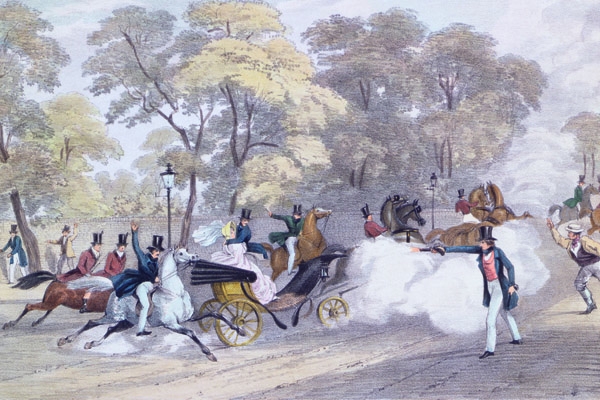On 10 June 1840 an 18-year-old out-of-work Londoner named Edward Oxford cocked his pistol and fired two shots at Queen Victoria as she made her daily carriage drive with Prince Albert on Constitution Hill. Oxford was mobbed by the crowd, who shouted ‘Kill him!’ He was charged with high treason. Though he claimed that his cheap flintlock pistol was loaded, no ball was ever found. Oxford, who (according to Prince Albert) was ‘a little mean-looking man’, delighted in the attention the shooting brought him. During the trial the family insisted that he was mad. He was found guilty but insane, and sentenced to confinement for life in Bethlem hospital.
Oxford was the first of seven men who attempted to kill or assault Queen Victoria. These attacks have received little attention in the history books, and they made only a fleeting impression at the time. Paul Thomas Murphy has had the inspired idea of writing the reign through the stories of Victoria’s would-be assassins.
Taking a pop at the Queen was a short cut to celebrity. The second attempt, a year later, was made by a ne’er-do-well named John Francis. Aged 20, he had quarrelled with his family and got into debt in a failed venture to set up a tobacco shop. In desperation, he bought a cheap pistol and fired at the Queen. Unlike Oxford, he was sane and, though he insisted that his pistol was not loaded, was sentenced to death (this was later commuted to transportation).
Only a few weeks later, Victoria was targeted by a deranged 17-year-old hunchback dwarf named John Bean. He pointed a dodgy pistol loaded with fragments of clay pipe at her. He managed to escape, but was eventually arrested after the police had rounded up all the hunchbacks in London answering to his description.
By now the politicians had realised that trying these crazy youths for high treason was not only ridiculous but also counterproductive. By glamorising their crime it gave them the attention that they craved. A new law was introduced, the Security of Her Majesty’s Person Act of 1842, which lowered the punishment to whipping and seven years’ imprisonment or transportation.
This was no deterrent to Robert Pate, a madman and (unlike the others) from a wealthy family. His obsession was goose-stepping round all the London parks. One day when he was going through a psychotic episode, he joined the crowd waiting for the Queen. When she appeared in her carriage, he stepped forward and thwacked her hard on the head with his cane. This was the only time that Victoria was actually hurt.
Unlike the terrorists who assassinated autocratic rulers such as the Russian tsar Alexander II, Victoria’s attackers were not radicalised, nor did they belong to bigger conspiracies. Potentially the greatest threat to the Queen’s security came from disaffected Irish nationalists, but the two Irishmen who assaulted her were pathetic loners. One was a 24-year-old bricklayer’s labourer, a drifter named William Hamilton who fired a shot (again no bullet). All he wanted was to get arrested in order to be sent to prison, where he would be fed.
Seventeen-year-old Arthur O’Connor was the great nephew of the Chartist leader Feargus O’Connor. He was a romantic youth who planned to die as an Irish martyr in the Fenian cause, but he had no connection with the violent nationalist Fenian movement. He managed to jump over the wall of Buckingham Palace and confront the Queen in her carriage eyeball to eyeball in 1871. Though O’Connor’s pistol turned out to be broken, Victoria found his attack the most frightening, because of his sheer proximity. She credited her rescue entirely to her faithful servant, John Brown, whom she rewarded with a gold medal.
The only man who fired at the Queen with a loaded gun was Roderick Maclean, her last attacker, who ambushed her in her carriage as she emerged from Windsor station. He was a madman living rough, a paranoid psychotic who was confined to an asylum for life.
These crimes reveal a society obsessed, like our own, with instant celebrity, but where there was little organised opposition to monarchy. In a world where mental illness was untreatable and firearms were freely available, assassination was bound to be relatively high-risk. The punishment of banishment to Australia, however, turned out to be remarkably productive. Several of the attackers were rehabilitated and, after years of hard labour, they began successful new lives as respectable and sane citizens.
Murphy contends that the assassination attempts played a key part in the development of modern monarchy. After each of the first five attacks, Victoria insisted on driving around London as if nothing had happened. On one occasion she refused to cancel a public appearance, even though it was known that the would-be murderer was in the crowd. She was met by cheering crowds, and Murphy claims that the near- disasters somehow renewed and strengthened her contact with her people.
Victoria’s popularity was undoubtedly boosted by her remarkable personal courage, but Murphy doesn’t really prove his point that this was the invention of modern monarchy. After Albert’s death in 1861 Victoria became almost invisible, and for 40 years the widow of Windsor hid from her people and refused to make any public appearance. This hardly suggests that she considered contact with her people essential to the conduct of monarchy.
This book is not really a historical argument but a rollicking read. Murphy vividly conveys the grime and despair of the attackers’ lives, and he uses newspaper reports and trial transcripts to reconstruct the brutal world of the courts, the prisons and madhouses. He has written an enjoyable account, counterpointing the two extremes of Victorian society — the Queen and the desperate dregs — joined by that brief moment when the attacker cocked his (unloaded) pistol.






Comments